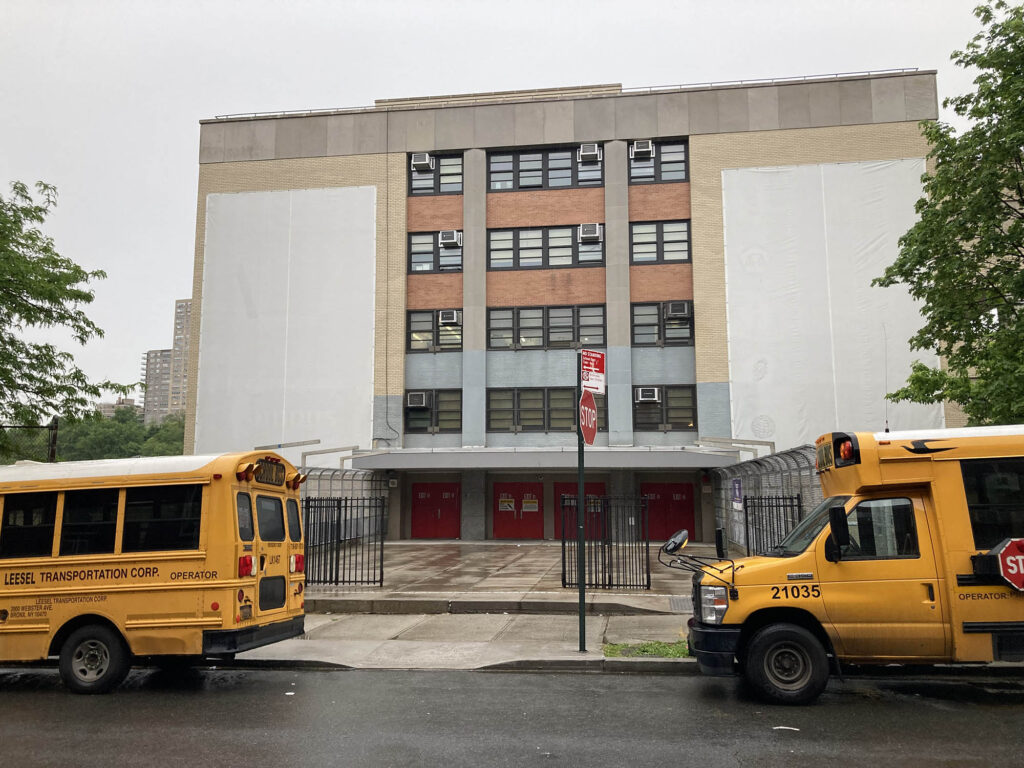
Photo by Síle Moloney
New York Legal Assistance Group (NYLAG) announced that on Friday, June 13, a U.S. immigration judge granted a motion to reconsider the improper dismissal of the asylum case of “Dylan,” a Venezuelan-born, high school student attending English Language Learners and International Support Preparatory Academy (ELLIS) in Marble Hill.
As reported, Dylan had been detained by U.S. Department of Immigration and Customs Enforcement (ICE) officials when he reportedly appeared at a Manhattan courthouse for a routine hearing on May 21. For more, on the reason provided by ICE as to why Dylan was detained, read our previous story. According to NYLAG, after being moved around the country since his detainment, Dylan was most recently held in a Pennsylvania detention center.
As reported, the New York Immigration Coalition (NYIC), education advocates, allies, immigrant New Yorkers, and elected officials, including Councilman Eric Dinowitz (C.D. 11) had rallied and held a press conference on the steps of Tweed Courthouse in Manhattan on Thursday, May 29, to demand the immediate release of Dylan.
Advocates called for Dylan’s release and urged the New York State Legislature to take action by passing the New York for All Act, which would prohibit local and state law enforcement from colluding with ICE officials. NYIC officials said the legislation is essential to ensuring every New Yorker has the right to due process.
NYLAG officials said the latest decision “marks an important step forward in restoring due process rights to Dylan (whose last name is being withheld for privacy) by reinstating his pending asylum claim and pursuit of additional protections under Special Immigrant Juvenile Status (SIJS).”
They said it also represents an important victory for NYLAG, who filed the emergency motion on Dylan’s behalf. They said the motion was granted after audio recording from his original hearing revealed the government failed to properly inform Dylan, who appeared pro se without a lawyer at the time, about the full consequences of the dismissal of his asylum hearings, and that the government potentially misled him of options he had after dismissal, which directly laid the groundwork for his imminent arrest.

Photo by Síle Moloney
Per the decision, “[T]he Court will grant the motion to reconsider because the Department [of Homeland Security]’s motion to dismiss was procedurally flawed and greatly prejudicial to a pro se Respondent with a pending application for asylum and related protection.” […] “By reconsidering its dismissal and reopening these removal proceedings, the Court corrects its failure now.”
“We are grateful for this decision, which allows Dylan to continue his pursuit of asylum, as he should have been allowed from the beginning without ever having been ripped away from his life, his family or his community and placed in detention where he unconscionably still remains today,” said Melissa Chua, co-director of NYLAG’s Immigrant Protection Unit and lead attorney representing Dylan. “This is an important acknowledgement of what was clearly an outrageously unjust and misleading violation of due process and of Dylan’s civil and human rights.”
She continued, “Dylan’s case is unfortunately representative of a nationwide practice to deprive asylum seekers like Dylan of due process rights and to expeditiously remove them from the country. This decision makes it clear that this practice is extremely difficult for pro se Respondents to navigate and particularly prejudicial. We will continue to fight day and night to release Dylan from his unjust detention, to ensure he is finally properly given his day in court and to hold DHS and the courts accountable for upholding due process rights for all people.”

Photo by Síle Moloney
NYLAG shared the following key findings (excerpted from the decision):
For the reasons detailed below, the Court grants Respondent’s motion to reconsider and reopens these removal proceedings:
-
The Court did not give either party sufficient time to develop the record on why these proceedings should or should not be dismissed.
-
Respondent was not provided a meaningful opportunity to make an informed decision about whether he opposed the Department’s motion to dismiss his removal proceedings.
-
His failure to object to the Department’s motion is attributable to the fact that he lacked the information necessary to make a knowing and informed decision.
-
Respondent should have been on the Court’s juvenile docket with an immigration judge who understands the nuances of the law as it applies to juveniles.
-
Respondent and his mother were confused about the consequences of the Department’s motion to dismiss, especially as it related to his opportunity to pursue SIJS and asylum relief.
-
The Court allowed Respondent only a brief opportunity to consult with his mother. Because Respondent is a young man appearing pro se, this was insufficient to afford Respondent due process and a meaningful opportunity to participate in his proceeding.
-
The Court has a duty to develop the record and to ensure pro se respondents understand the legal consequences of the decisions presented to them. Importantly, the answers that the Court and the Department gave to Respondent’s and his mother’s questions about the possible dismissal were imprecise and potentially misleading.
-
The Department did not inform Respondent or this Court that if these removal proceedings were dismissed it intended to initiate expedited removal proceedings against Respondent and detain him immediately.
-
Instead, the Department reassured this Court that if proceeding were dismissed, Respondent could continue to seek SIJS as “collateral” relief and could file an affirmative asylum application with [U.S. Citizenship and Immigration Services].
-
Respondent was not advised that if proceedings were dismissed, he would be placed in expedited removal proceedings where he would only be eligible for asylum if he requested and passed a credible fear interview, at which point he would be issued a new [Notice to Appear] and be placed—again—in [immigration court] proceedings.
-
When the Department moved to dismiss these proceedings, it knew that Respondent feared being returned to Venezuela because he had already filed an asylum application with the Court. The Department also knew that the Court was prepared to hear Respondent’s application for asylum and related protection at the next hearing.
-
-
Respondent seeks, through his asylum application, the statutory protection of withholding of removal under the Convention Against Torture. Where a respondent has filed an application for asylum and related protection, he has a significant interest in having his application adjudicated by an immigration judge because the immigration court has sole authority to adjudicate applications for withholding of removal and protection under the Convention against Torture.
-
The Department’s motion to dismiss was procedurally flawed and greatly prejudicial to a pro se Respondent with a pending application for asylum and related protection. The Department did not seek Respondent’s position before filing its Motion to Dismiss as required by the Immigration Court Practice Manual, without providing an articulated reason for its failure to do so. Had this Court originally required the Department to comply with the practice manual, perhaps the record would have been developed sufficiently so that Respondent could make an informed and knowing decision about the consequences of dismissal. By reconsidering its dismissal and reopening these removal proceedings, the Court corrects its failure now.
NYIC are calling on the City to pass and strengthen the NYC Trust Act, which would reinforce protections for immigrant New Yorkers by limiting the cooperation of New York City, a Sanctuary City, with ICE. Additionally, advocates are demanding a $180 million investment in immigration legal services, critical funding needed to provide representation for families like Dylan’s, keep communities together, and uphold what they said is New York’s commitment to justice, safety, and opportunity.
For more on this topic, click here, here, here here, here, here, here, here, here, here, and here.




